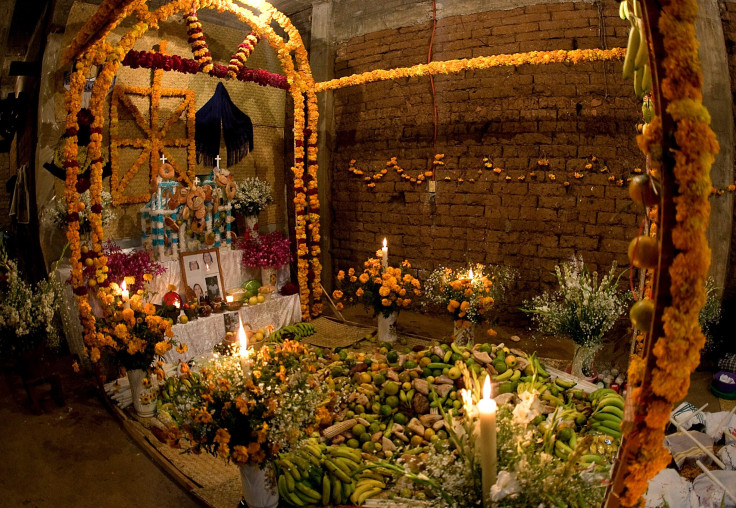
Día De Los Muertos is one of the most important traditions celebrated throughout Mexico and by Mexicans around the world. The tradition focuses on celebrating and remembering friends and family who have passed away. One of the most important elements of Día De Los Muertos is the altar, elaborate constructions to celebrate those family members who have left the mortal world. These are usually created inside people's homes, but can occasionally be seen in schools and public places. The altar usually contains a combination of pagan and religious imagery as well as photos of the deceased and samples of their favorite food, drink or clothing.
Día De Los Muertos altars are one of the most important elements of the yearly celebration. The altar is a fascinating mixture of symbolism that comes from both native traditions and Catholic beliefs brought to Mexico by the Spanish conquistadors. As such, it is highly representative of Mexican culture, which itself is an incredible amalgamation of traditional indigenous beliefs and customs combined with elements of European tradition and aesthetics. The 'ofrenda' or offering is any item placed on the altar which represents a gift to the deceased: be it their favorite food, a particular smell or a shot of tequila, ofrendas are our way of showing our love towards deceased relatives. The altar is a complex creation with incredible symbolism as each elements carries specific meaning. Here are the most important elements and what they mean.
Levels: "Altares" can be made up of two, three or seven levels. Two levels is a representation of the divsion betwen the earth and the sky, the fruits of the land and the elements of the air, rain, wind, sunshine. Altars with three levels represent the sky, the earth and the underworld. This relates to the Aztec belief system. However, following European conquest, this meaning has changed. Under a Christian world view, the three levels could be either hell, heaven and earth or a representation of the Holy Trinity. Altars with seven levels are the most common and relate to the seven levels that a soul must traverse before reaching heaven (or hell). It also relates to the Seven Deadly Sins.
Lantern: A lantern hanging above your altar is a guiding light so that the dead can find their way home. It is also a reference to the Star of Bethlehem that led the Wise Men to the birth of the Savior.
Arch: Above the altar is usually a large arch made of flowers or other offerings. It represents the entry into the world of the dead and in seven-leveled altars it represents the eigth level in the Aztec belief system, the penultimate level in the underworld of Mictlan.
Paper: "Altares" usually have "papel china" or tissue paper, typically in yellow and purple, made into intricate designs. They are a representation of the union between life and death.
Banquet: To celebrate the arrival of your deceased loved ones, a banquet of their favorite food and drink items is placed as an offering. This can include alcohol, choclate, candy and cigarettes.
Incense: A chalice with incence or copal (an aromatic tree resin used in indigenous ceremonies) is placed on the altar. It is a way to purify the souls of the dead and ward off evil spirits.
Salt: Salt is usually placed on a plate and stops the souls of the deceased from being corrupted by earthly temptations.
White Cross: A cross made of slaked lime is drawn on the ground under the altar. It orignally represented the four cardinal points corresponding to the four elements. Now it is also a representation of the Christian cross.
Typical Food: As well as the deceased's favorite food items, altares usually contain traditional Day of the Dead food items such as Pan de Muerto, rice, mole, pumpkin, sugar cane, jicama and oranges - the fruits of the season.
Water: A glass of water is often placed on the altar. This is to quench the thirst of the deceased and strengthen them for their return journey.
Fire: Fire in the form of candles and torches are symbols of our love for our deceased relatives and guiding lights for their spirits.
Flowers: Flowers are not just a beautiful visual and olfactory addition to the altar. Yellow flowers, or cempasuchil, are a guide for the spirits into the mortal world. White flowers represent the sky, while purple flowers are the traditional color of mourning in Mexico.
Calaveras: "Calaveras" or skulls are representations of deceased relatives. Made of sugar or chocolate and often consumed by kids after the celebration, they are an example of the Mexican ability to celebrate, mock and play with death.
© 2024 Latin Times. All rights reserved. Do not reproduce without permission.
